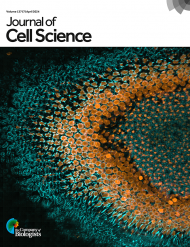26 June 2025
by Godwin Pius Ohemu
Godwin Pius Ohemu is an MSc graduate in epidemiology from the University of Port Harcourt, Nigeria, and holds a Postgraduate Diploma in Global Health Research from the University of Oxford, UK. As a member of The Global Health Network team, Godwin provides digital support for the AMR Knowledge Hub, a platform designed to advance antimicrobial resistance (AMR) research. Godwin attended the Biologists @ 100 conference; here he relays his experience at our DMM-hosted one-day programme on AMR.

The one-day programme on antimicrobial resistance (AMR) at the Biologists @ 100 conference, hosted by The Company of Biologists, was nothing short of energising, especially for early-career researchers such as myself who are passionate about tackling the global burden of AMR. The theme, “Interdisciplinary approaches to combatting antimicrobial resistance,” wasn’t just a catchy phrase for a one-day programme hosted by the journal Disease Models & Mechanisms (DMM); it fully captured what the day was all about. With three major sessions and 12 presentations in total, one clear message emerged: we need to work together across disciplines, contexts and countries if we’re going to effectively address the challenges of AMR.

Here’s how the day unfolded:
- One bold theme: Interdisciplinary approaches to combatting antimicrobial resistance
- Three rich sessions:
-
- Drug discovery in the ‘omics era
-
- Cellular mechanisms of AMR
-
- Detecting and tackling AMR in the environment and clinics
- 12 impactful presentations, each offering a unique perspective into the world of AMR
Drug discovery in the ‘omics era—innovation meets integration
The first session of the day offered some of the most promising directions for AMR drug development. A presentation on “Targeting AMR solutions from natural products using laboratory automation and integrated ‘omics” by Roger Linington of Simon Fraser University, Canada, set the tone, explaining how automation, data science and natural product libraries can combine to identify novel antimicrobial compounds faster and more efficiently. The next talk, from Nadine Ziemert, University of Tübingen, Germany, looked at mining genomes and algorithms from new antibiotics and developing oligopeptide-modified oligonucleotides to directly target ESKAPE pathogens, a group of six highly virulent and antibiotic-resistant bacterial pathogens. One particularly thought-provoking talk, by Marla Macias of Newcastle University, UK, looked at how adjusting temperature and salinity could modulate microbial metabolism, unlocking bioactive compounds in organisms like Rhodococcus and Micromonospora. The big takeaway from this section was that drug discovery’s future lies in the synergy between biology, technology and environmental cues.
Cellular mechanisms of AMR—understanding the battlefield
Moving into the second session, we were reminded that mitigating the burdens of AMR in different settings isn’t just about discovering new drugs, it’s also about understanding how bacteria resist drugs. Talks such as “The ins and outs of antibiotic accumulation in Gram-negative bacteria” by Jessica Blair of the University of Birmingham, UK, revealed how structural barriers in bacterial membranes influence drug efficacy. Another fascinating presentation, by Maximiliano Gutierrez, of the Crick, UK, looked at the role of the host environment in determining how well antibiotics work. We also discussed the mechanisms behind multiple antibiotic resistance in enteric bacteria; one standout presentation, “Microbial warfare: a driver of antimicrobial resistance?” by William Smith of the University of Manchester, UK, challenged us to think about how microbial interactions themselves shape resistance dynamics. The second session of this one-day programme left me reflecting on the fact that drug resistance is not static. It’s dynamic, multi-layered and influenced by both internal microbial strategies and external pressures.
Detecting AMR / persistence in the environment, clinical case studies, solution science, impact and innovation
This session meant a lot to me as I excitedly waited to hear and learn from Iruka Okeke of the University of Ibadan, Nigeria, for the first time. I found myself completely absorbed in the case studies she presented, learning about vaccine development, wound biofilms and small molecules that could prevent bacterial adherence.
One presentation that particularly piqued my interest as an early-career researcher was by Jack Barber of the University of Aberdeen, UK, on “Understanding disparities in antibiotic-resistant infections and antibiotic exposure in socioeconomically disadvantaged populations: Setting the agenda”. He broke his talk into three powerful layers: structural determinants of health, social determinants of health, and individual and behavioural factors. That stuck with me because we often think of AMR as a scientific or medical issue alone, but it’s also deeply social. Many of us fall into the third category: whereby our own behavioural choices, including overuse, misuse, and underuse of antibiotics, poor hygiene and inadequate follow-through on prescriptions, directly or indirectly fuel the problem of drug resistance. Jack made it clear: AMR is not just a laboratory issue, it’s a public health issue, a socioeconomic issue and a justice issue.
Lessons learned and moving forward
Across all 12 presentations, three lessons stood out for me:
1. Interdisciplinary research is not optional; it’s essential. From bioinformatics and ‘omics to environmental science and social justice, everyone has a role to play.
2. Technology must be used to close gaps, not widen them. Whether it’s automation in the lab or algorithms for genome mining, these tools should help us reach the underserved and the overlooked, not just the well-funded.
3. Equity matters. Any conversation about AMR that ignores the social determinants of health is incomplete.
These twelve talks, put together, told a complex story; a story of collective action, of science driven by purpose and of the urgent need for collaboration if we’re to stand any chance in the battle against AMR. We’re not there yet, but the one-day programme on AMR at the Biologists @ 100 conference showed us that, with interdisciplinary, interprofessional and intersectoral approaches and collaboration, we’re heading in the right direction.








You must be logged in to post a comment.